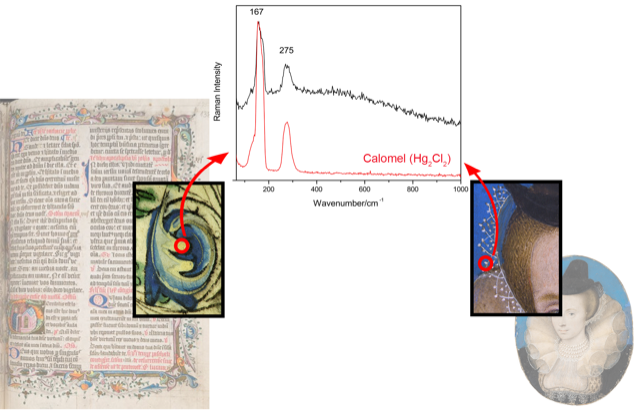New evidence for the intentional use of calomel as a white pigment
The paper “New evidence for the intentional use of calomel as a white pigment” is co-authored by Mila Crippa, Stefano Legnaioli, Christine Kimbriel and Paola Ricciardi. It is now published in the Journal of Raman Spectroscopy and is available in open access thanks to an NHSF Gold Open Access grant.
The paper discusses the use of in-situ micro-Raman spectroscopy for the identification of calomel - a mercury (I) chloride mineral with formula Hg2Cl2 - as a white pigment in a 15th-century English manuscript and a late 16th-century portrait miniature by renowned limner Isaac Oliver, both belonging to the Fitzwilliam Museum in Cambridge, UK.
Although mercury chloride compounds have been employed for centuries in different fields including medicine, electrochemistry and cosmetics, the deliberate use of calomel as a pigment has been identified only recently within a few 17th-century South American objects. The present research, however, attests the first-ever verified presence of calomel within the original painting palette of two Western European works of art, predating its documented use in South America.
With ever-increasing possibilities to undertake non-invasive analyses of museum objects, it is quite possible that in the near future, calomel will no longer be considered an unusual pigment but rather will take its place as an integral part of the palette used by artists in different times and places.
The research behind this paper has been financially supported by the Cambridge Humanities Research Grants scheme, the Zeno Karl Schindler Foundation and a Short Term Mobility grant from the Italian National Research Council (CNR).

(Left) Full-page image and detail from the so-called "Fitzwilliam Missal" (Cambridge, Fitzwilliam Museum, MS 34, fol. 138r, York, England, ca. 1470) with coloured dots indicating where Raman analysis was performed; (Centre) Raman spectrum obtained from the white areas analysed on both objects (black line) and reference Raman spectrum of commercially available Hg2Cl2 (red line); (Right) full image and detail of the portrait of an Unknown Lady by Isaac Oliver (Cambridge, Fitzwilliam Museum, FM 3868, England, ca. 1596-1600) with coloured dots indicating where Raman analysis was performed. Image from: https://doi.org/10.1002/jrs.5876.
